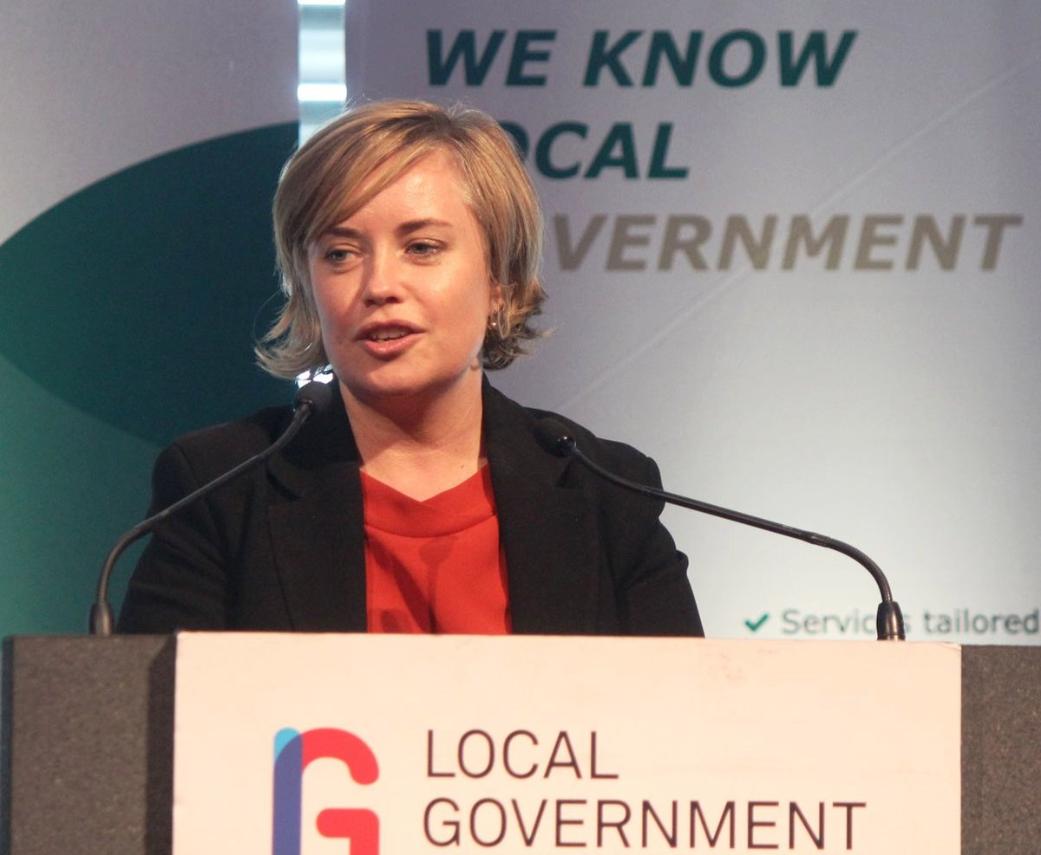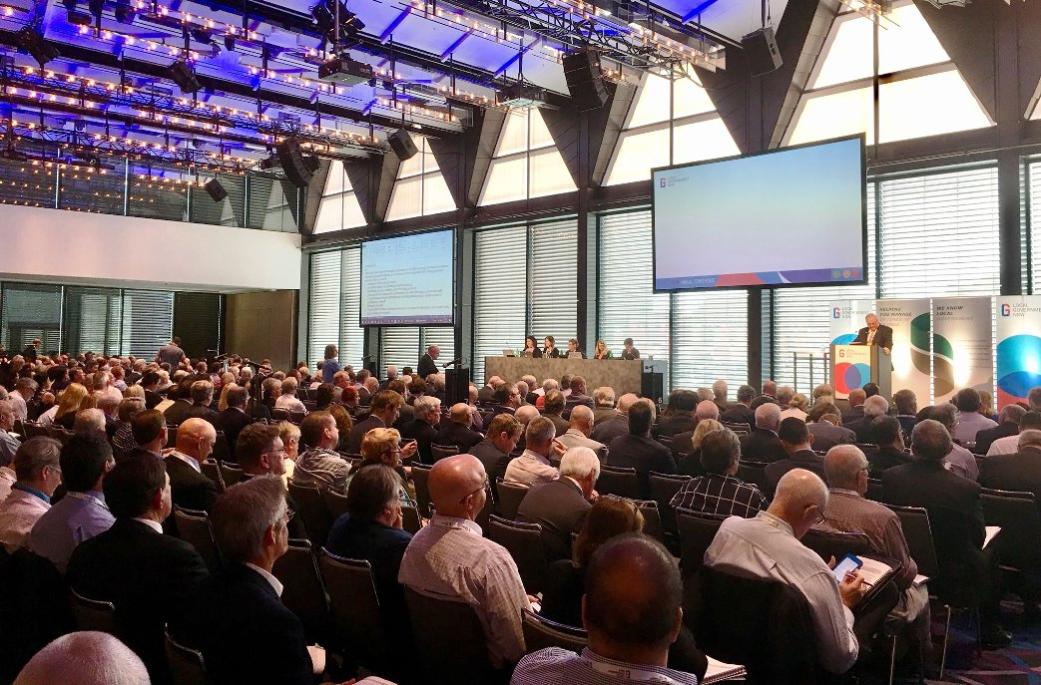LGNSW Conference 2017: Overview

Anger that councils were forcibly amalgamated may be viewed as still persisting in the Record of Decisions through Items 85 and 82:
85 Inner West Council Binding referendum on amalgamations
That NSW Local Government’s policy on amalgamations includes the requirement that where an amalgamation with one or more councils is proposed there be a binding referendum in each council area asking voters if they want their council to be amalgamated or not. In order for an amalgamation to go ahead, each council area would need to achieve a majority vote in favour of the amalgamation.
Carried
82 Lane Cove Council Lack of consultation by State Government with local government
That Local Government NSW lobbies the Minister for Local Government for improved consultation with the local government sector, so that prior to the introduction into Parliament of any legislation affecting the sector, that the State Government consults and engages with LGNSW.
Carried
This reflects the recently defeated Bill passed by the Upper House on the same idea (Local Government Amendment (Amalgamation Referendums) Bill 2017); to allow individuals to vote on amalgamations and for their voices to count, although clearly this would need to be conducted along old council boundary lines to be democratic when smaller councils are remerged with larger councils with larger populations, if taken now.
Perhaps those still wanting their chosen council back may take heart in the statement released this week by the SOCC President:
Our aim in the next twelve months is to build our organisation and continue to show amalgamations do not work, support those seeking de-amalgamation and take action on all the other threats to local democracy coming from this Government.
BT Halstead, Save Our Councils Coalition President - 8th December, 2017
A regeneration in objecting to what were once council areas of jurisdiction appears in the Record of Decisions through Item 4:
4. Board Mandatory Independent Hearing and Assessment Panels
That Local Government NSW calls on the NSW Parliament to revoke legislation that mandates Independent Hearing and Assessment Panels (IHAPs) for all councils in Sydney and Wollongong.
Amendment
i. That Local Government NSW campaigns with NSW councils against the State Government takeover of planning powers through IHAP legislation.
ii. That Local Government NSW calls on the NSW Parliament to revoke legislation that mandates Independent Hearing and Assessment Panels (IHAPs) for all councils in Sydney and Wollongong.
Amendment carried – became Motion
Motion carried
This was backed up by related Items:
6 Canterbury-Bankstown Council Impact of urban growth strategies on open space
That Local Government NSW calls upon the State Government to consider the impact of urban growth strategies on open space in local communities, particularly to consider unique and innovative ways to increase open space in priority growth areas to improve the liveability of the precincts as the population increases. Carried
7 Central Coast Council Proposed Public Conservation Zone
That Local Government NSW requests the NSW Department of Planning and Environment to amend the Standard Instrument (SI) Principal Local Environmental Plan (LEP) to include, within the Land Use Table a new zone, Zone E5 Public Conservation.
Carried
8 City of Sydney State Significant Development
That Local Government NSW: a) adopts a policy to oppose the current conception of State Significant Development (SSD) provisions in the NSW Planning legislation that allow for the large-scale resumption of land owned and managed by councils; and b) advocates to the NSW Government that the NSW Planning legislation be reformed to change the requirements for the NSW Government to declare areas as State Significant to ensure: (i) there is a clear justification of public benefit; and (ii) that if the land is owned by a council, a clear timeframe is outlined to hand the land back to the council.
Carried
18 Bellingen Shire Council RMS handover arrangements
That Local Government NSW advocates to the State Government for an immediate change in policy position in relation to the handover of NSW Roads and Maritime Services (RMS) assets to local government so that the determination is made by the Independent Pricing and Regulatory Tribunal (IPART), taking into account the council’s long term financial position and communities’ capacity to pay so that no increased financial burden is placed upon the community in question and to provide transparency and accountability that does not exist in the current process.
Carried
What didn't appear among the Items recorded is the current NSW Department of Environment and Planning Draft SEPP announcement that Urban Bushland is to be renamed 'Public Bushland' and transferred out from under councils to a Ministerial Direction. Fortunately the date for submissions on this Draft SEPP has been extended until January 31st, 2018.
Urban Bushland includes all land that is zoned non-rural, and owned or managed by a council or a public authority, or reserved for acquisition for open space or environmental conservation by a council or a public authority, and that has vegetation which meets a clear definition of bushland.
- The majority of the provisions of SEPP 19 will be transferred to SEPP (Environment). These provisions will be updated and some will be transferred to a Ministerial Direction.
- Update council names to reflect recent council amalgamations and boundary changes.
- Extend its land application to cover local government areas that are currently partly outside the application of SEPP 19 including parts of Hawkesbury and Central Coast local government areas.
- Transfer plan making provisions in SEPP 19 to a Ministerial Direction.
- A new circular on Urban Bushland is being finalised for consultation. It has been developed to provide further information and detail regarding the application of SEPP 19. This circular will replace planning Circulars No. B13 and No. 114.

State Environmental Planning Controls(Draft Environment SEPP):Urban Bushland
- The majority of the provisions of SEPP 19 will be transferred to SEPP (Environment). These provisions will be updated and some will be transferred to a Ministerial Direction.
- Update council names to reflect recent council amalgamations and boundary changes.
- Extend its land application to cover local government areas that are currently partly outside the application of SEPP 19 including parts of Hawkesbury and Central Coast local government areas.
- Transfer plan making provisions in SEPP 19 to a Ministerial Direction.
- A new circular on Urban Bushland is being finalised for consultation. It has been developed to provide further information and detail regarding the application of SEPP 19. This circular will replace planning Circulars No. B13 and No. 114.
Definitions. 1.1 “Bushland” – land on which there is vegetation which is either a remainder of the natural vegetation of the land, or, if altered, is still representative of the structure and floristics of the natural vegetation. 1.2 “Urban” – pertaining to or occurring or situated in a city or town.
State Environmental Planning Policy No 19—Bushland in Urban Areas
Current version for 22 February 2014 to date (accessed 9 December 2017 at 10:01)
Aims, objectives etc
(1) The general aim of this Policy is to protect and preserve bushland within the urban areas referred to in Schedule 1 because of:
(a) its value to the community as part of the natural heritage,
(b) its aesthetic value, and
(c) its value as a recreational, educational and scientific resource.
(2) The specific aims of this policy are:
(a) to protect the remnants of plant communities which were once characteristic of land now within an urban area,
(b) to retain bushland in parcels of a size and configuration which will enable the existing plant and animal communities to survive in the long term,
(c) to protect rare and endangered flora and fauna species,
(d) to protect habitats for native flora and fauna,
(e) to protect wildlife corridors and vegetation links with other nearby bushland,
(f) to protect bushland as a natural stabiliser of the soil surface,
(g) to protect bushland for its scenic values, and to retain the unique visual identity of the landscape,
(h) to protect significant geological features,
(i) to protect existing landforms, such as natural drainage lines, watercourses and foreshores,
(j) to protect archaeological relics,
(k) to protect the recreational potential of bushland,
(l) to protect the educational potential of bushland,
(m) to maintain bushland in locations which are readily accessible to the community, and
(n) to promote the management of bushland in a manner which protects and enhances the quality of the bushland and facilitates public enjoyment of the bushland compatible with its conservation.
Bushland is defined as ‘land on which there is vegetation which is either a remainder of the natural vegetation of the land or, if altered, is still representative of the structure and floristics of the natural vegetation.